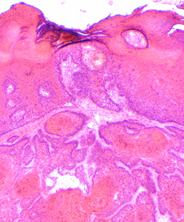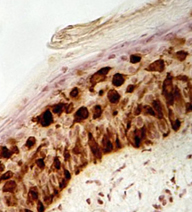Skin cancer is the most common form of cancer in the United States, with more than five million new cases diagnosed every year. Untreated skin cancers can be very dangerous, but with early detection and intervention most are curable.
Basal cell carcinoma (BCC) is the most common form of cancer and BCC’s arise from cells in the epidermis, or outermost layer in the skin. Ultraviolet light exposure from the sun is linked to development of skin cancer, including BCC, which occurs most commonly on sun exposed areas of the body such as the face, ears, neck, scalp, shoulders and back.
Basal cell carcinoma is diagnosed with a simple skin biopsy performed under local anesthesia. Although BCC can be locally destructive, it has a very low rate of metastasis and is not usually life threatening. More than one treatment technique is available for BCC, but Mohs surgery is cost effective and cure rates approach 99% for primary and recurrent BCC’s.

Squamous cell carcinoma (SCC) is the second most common skin cancer and arises from cells in the epidermis, or outmost layer of the skin. Ultraviolet light exposure from the sun is linked to development of SCC, however other potential causes are: chronic wounds, exposure to X-ray or chemicals (such as arsenic, petroleum by-products) and immunosuppression.
Squamous cell carcinoma is diagnosed with a simple skin biopsy performed under local anesthesia. Most skin SCC’s are not serious when they are identified early and treated promptly. Cure rates with Mohs surgery can approach 99%. However, there is a relatively small percentage of SCC’s that behave aggressively and have the ability to spread to lymph nodes and/or distant organs.

Melanoma is the third most common type of skin cancer. Melanoma originates from melanocytes, cells that produce the pigment that colors our skin, hair and eyes. Melanoma onset, like BCC and SCC, is linked to ultraviolet light exposure from the sun. Imperfect repair of sun damage in melanocytes by the immune system may lead to development of melanoma, and since immune function is at least partly inherited, predisposition to the development of melanoma is often regarded as “hereditary.”
Although melanoma is the most common cause of skin cancer related death, most melanomas can be successfully treated with early detection and surgical removal. The highest cure rates achievable start with Mohs surgery, where melanoma is surgically removed and tissue margins are meticulously evaluated with frozen sections and special melanocyte stains called immunostains.
Doctor Bricca is very skilled using immunostains for melanoma treatment because he played an integral role in developing the original laboratory protocol in 2004 (see “Meet Dr.Bricca” section and “Journal Publications”) that is still used today by Mohs surgeons throughout the country.










